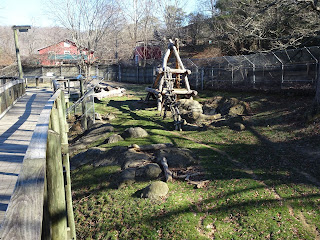There
is a wildness to the Carolina coast in the winter, one that is not so readily
visible in the summer when the beaches are filled with sunbathers and laughing
children. The wind coming off the water is unlike that of a spring thunderstorm,
and the chill that accompanies it brings tears to your eyes. The waves seem harsher,
the dunes less contained, even the sky has a desolate aura of abandonment.
We
emerged from the Hampton Inn Outer Banks to an empty stretch of shore. While
there are plenty of homes along the stretch between Duck and Corolla, we were
the only people as far as the eye could see; a marked contrast to the constant
stream of cars riding up and down the beach north of Corolla. We chose the
hotel partially due to the (comparatively) remote location, and also as it
would put both Corolla and Duck within an easy drive; we had planned to see the
wild horses on one day, and the Wright Brothers National Memorial the next.
The
beach was littered with shells. The boys immediately started collecting, but at
moments I would look up to see them facing the ocean, lost in thought, shells
washing in and out at their feet. My bag started to fill as well, the color
purple catching my eye most often: scallops and cockles, carditids and tellins.
A
squadron of pelicans flew overhead, the bright sun reflecting off their white
bodies in Morse code of flashes. While the air traffic slows down during the winter,
the Outer Banks remain a prime area for bird-watching. Right across the street on the
Currituck Sound side is the last piece of untouched property on the
northeastern portion of the Outer Banks, the Donal C. O'Brien Sanctuary and Audubon Center at Pine Island. Preserving 2,600 acres of marsh, upland maritime
forest and sandy beaches, the Sanctuary remains largely free from development,
so birds and wildlife can continue to have a safe place to thrive free from
human disturbance. The entrance to the 2.5-mile nature trail is directly opposite
the hotel, and during the summer it is possible to take kayak tours and
participate in other public programs.
It was
inevitable – the feet get wet. The allure of a shell tumbling back out with the
surf, or a careless moment while the mind wanders… The waves relentlessly tug
at the sand, and the ceaseless repetition of the tides mesmerizes and
captivates. Although it might have been the wet shoes and cold feet that
eventually forced us indoors, once we retreated we noticed our cheeks were
stinging and fingers were tingling. However, we had found what we had been
searching for: the surf, the shells, the seclusion. Suddenly famished, we
filled our bellies and afterwards spread out our discovered shells, already dreaming what
treasures the ocean would bring us next.




















































